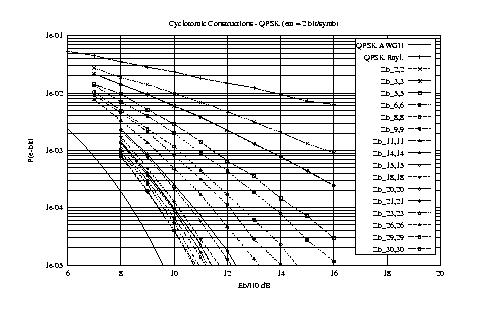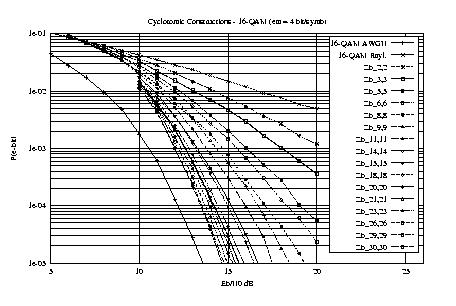 |
 |
| We briefly
explain how lattices can be constructed using algebraic number theory.
We assume some basic knowledge of algebraic number theory (for an
introduction to the topic, see [OV04]).
We first consider a number field, that is a field extension of Q, that we denote by K. Assume its degree over Q is n. Then, we consider OK,
its ring of integers, which furthermore possesses a basis B={ w1,...,wn}
over Z. Namely, every element x of OK can be written as
a integral linear combination of the wi, i=1...n. Suppose now that K is totally
real, that is, it has n real embeddings σi, i=1...n, into C. We call the canonical embedding
of K into Rn
the following map: σ=(σ1,...,σn).
By applying the canonical embedding to every element of the basis B, we
get a matrix, that can be shown to be the generator matrix of a lattice.
This construction can be generalized by considering not only a basis of OK,
but more generally a basis of an ideal of OK. Note that the
algebraic construction works for number fields of any signature (r1,r2) and yields a
diversity L=r1+r2, [BV98].
Using totally real number fields (r1=n and r2=0), we guarantee full
diversity L=n. In order to build a particular lattice of dimension n, we have to choose a number field K of degree n and an ideal I of OK. This is the procedure we are following for building Zn lattices. Note that in some cases, a twisting element may be added to get the desired lattice [BOV04]. We consider several constructions to build Zn lattices in all dimensions.
|
Some Bit Error probability curves
| The
following figures show the performance of rotated Zn
lattice constellations over the independent Rayleigh fading channel for
two different spectral efficiencies: 1 bit per dimension (as QPSK) and 2
bits per dimension (as 16-QAM). As the dimension (hence diversity)
increases, performance approaches the AWGN channel performance (lowest
curve). |
 |
 |
| [O05] | F. Oggier, Algebraic methods for channel coding, Ph.D. Thesis, EPFL, 2005. |
| [OV04] | F. Oggier and E. Viterbo, "Algebraic number theory and
code design for Rayleigh fading channels," in Foundations and Trends in Communications and Information Theory, vol. 1, pp. 333-415, 2004. |
| [BOV04] | E. Bayer-Fluckiger, F. Oggier, E. Viterbo, "New
Algebraic Constructions of Rotated Z^n-Lattice Constellations for the
Rayleigh Fading Channel," IEEE Transactions on Information Theory, vol. 50, n. 4, pp. 702-714, Apr. 2004. |
| [OB03] | F. Oggier, E. Bayer-Fluckiger, "Best rotated
cubic lattice constellations for the Rayleigh fading channel," Proceedings of the IEEE International Symposium on Information Theory, Yokohama, Japan, 2003. |
| [DAB02] | M.O. Damen, K. Abed-Meriam, J.-C. Belfiore, "Diagonal
algebraic space-time block codes," IEEE Transactions on Information Theory, vol. 48, pp. 628-636, Mar. 2002. |
| [BV98] | J. Boutros and E. Viterbo: "Signal Space Diversity: a
power and bandwidth efficient diversity technique for the Rayleigh
fading channel," IEEE Transactions on Information Theory, vol. 44, n. 4, pp. 1453-1467, July 1998. |
| [GBB97] |
X.
Giraud, E. Boutillon, and J.C. Belfiore, "Algebraic tools to build modulation
schemes for fading channels," IEEE Transactions on Information Theory, vol. 43, n. 3, pp. 938-952, May 1997. |
| [BVRB96] |
J. Boutros, E. Viterbo, C.
Rastello, and Belfiore, J.-C., "Good lattice constellations for both
Rayleigh fading and Gaussian channels" IEEE Transactions on Information Theory, vol. 42, n. 2, pp. 502-518, March 1996. |
| [GBB93] |
X.
Giraud, K. Boulle, and J.-C. Belfiore, "Constellations Designed for the Rayleigh
Fading Channel," IEEE International Symposium on Information Theory, January 17-22, 1993, p. 342. |
| [BB92] |
K. Boulle and J.-C.
Belfiore: "Modulation
schemes designed for the Rayleigh channel," Conference on Information Sciences and Systems, Princeton, 1992, pp. 288-293. |
|
|